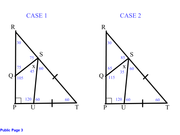shailendra.sharma wrote:1) Ideally I should not be coming in a situation for need of guessing. I scored 51 on this test - probably test tried to stumped be with tough question in last one minute.
well, there you go. see, you don't need to be perfect to get a perfect score.
nice!
2) The visualization trick that srcc25anu suggested could have been savior if I could come across. And until GMATGuruNY post I did not know I could even do smart number picking in geometry questions too.
testing cases (= "smart number picking")
on DS problems in particular is THE single most important strategy/technique you can adopt for solving math problems.
you may get the chance to test cases / "plug numbers" on as many as 10 different DS problems on the same exam (!). there's just no other strategy or technique that can even come close, in terms of raw productivity.
there's also the following 3 techniques for multiple-choice problems:
* backsolving (= start from an answer choice; do whatever you can with the given information; if everything agrees with everything else, you have the correct answer)
* "smart numbers" (= choose your own values for undetermined quantities; solve the problem with those values; check ALL the choices for your answer)
* estimation (including the use of visualization and/or common sense to produce your estimate)
for all of the above techniques, the most important thing to know is that
the techniques are general -- i.e., they do not fall within the boundaries of any subject or topic.
in other words, that you'd even make a statement such as "i didn't know i could do xxxxxx technique
on geometry problems" is not ideal; you shouldn't associate these techniques with particular problem topics.
instead,
whenever you get stuck, just think about whether you can use any of these alternative methods -- regardless of the subject/topic area of the problem.
it may be true that the techniques work
more often in certain areas. (for instance, backsolving generally works on at least half of all multiple-choice word problems, and "pick numbers" solves virtually
all remainder problems, especially in DS). however, the techniques are universal, so it's important that you not impose artificial limits on your ability (or willingness) to use them.
3) When I posed the question on guessing, I intended to know some trick out of Manhattan Advanced GMAT book.
when you look through that book, one main impression that you
should get is that most of the things in there are NOT "tricks". i.e., they are not little rules/facts/shortcuts that you can memorize.
instead, they are
mentalities that you can adopt in order to become a better problem solver across the board.
among the most important is the notion of
pattern recognition. in fact, i would say that at least half of the stuff in that book can be characterized as "recognizing patterns", which is pretty much the opposite of what anyone might reasonably describe as a "trick".























